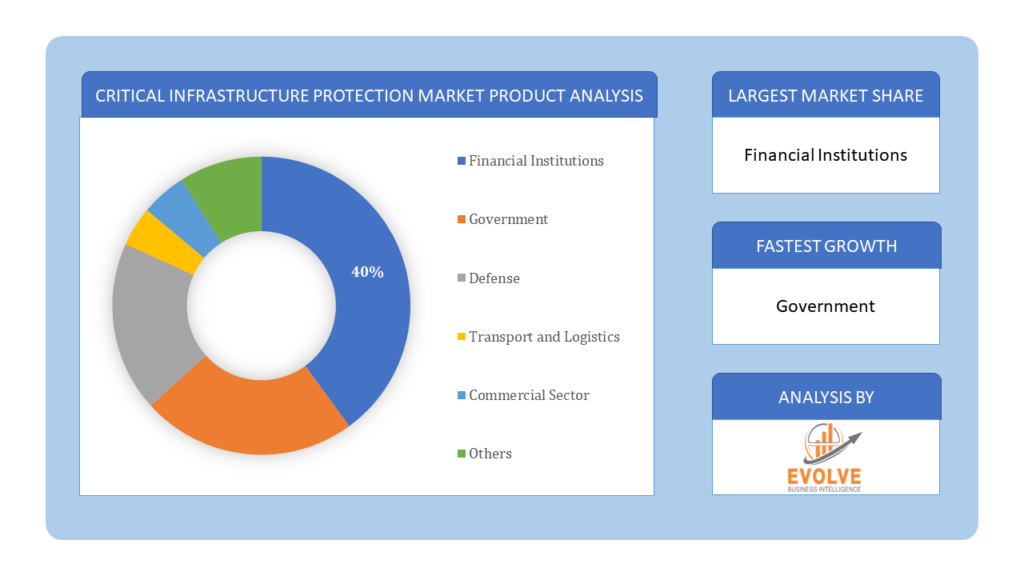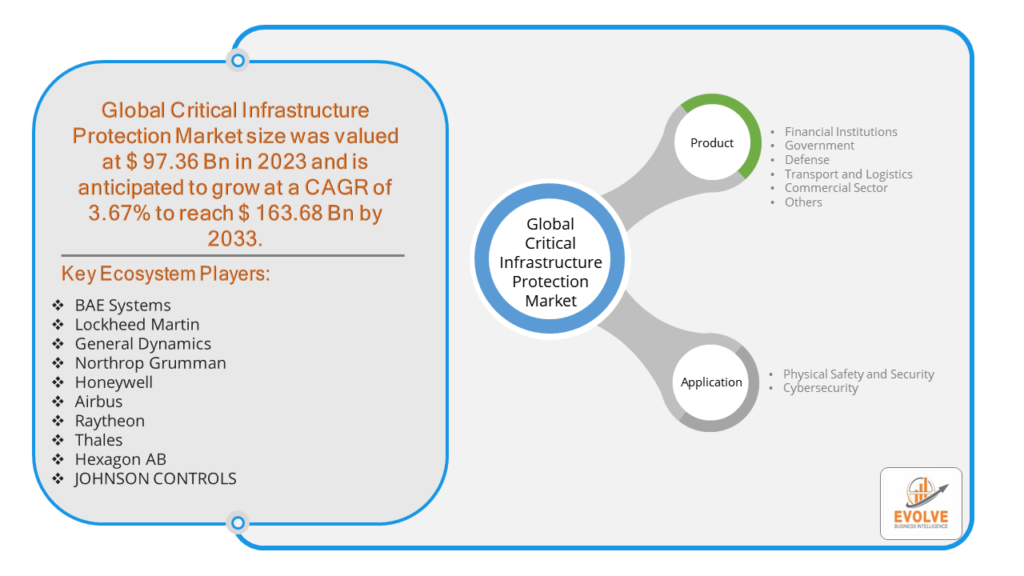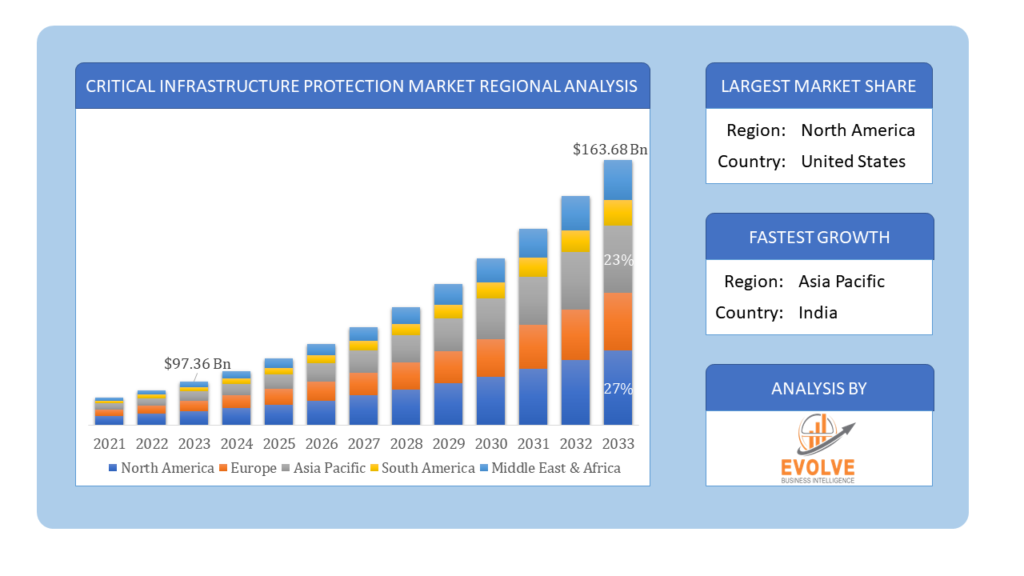Critical Infrastructure Protection Market Analysis and Global Forecast 2023-2033
$ 1,390.00 – $ 5,520.00Price range: $ 1,390.00 through $ 5,520.00
Critical Infrastructure Protection Market Research Report: Information By Verticals (Financial Institutions, Government, Defense, Transport and Logistics, Commercial Sector, Others), By Solutions (Physical Safety and Security, Cybersecurity), and by Region — Forecast till 2033
Page: 166
Critical Infrastructure Protection Market Overview
The Critical Infrastructure Protection Market Size is expected to reach USD 163.68 Billion by 2033. The Critical Infrastructure Protection industry size accounted for USD 97.36 Billion in 2023 and is expected to expand at a compound annual growth rate (CAGR) of 3.67% from 2023 to 2033. The Critical Infrastructure Protection (CIP) market focuses on safeguarding essential systems and assets vital for national security and public welfare from physical and cyber threats. It includes sectors like energy, transportation, telecommunications, and water supply. CIP solutions encompass technologies for threat detection, risk assessment, resilience planning, and emergency response. Key players in this market develop advanced surveillance systems, cybersecurity tools, access control mechanisms, and disaster recovery strategies. The market is driven by increasing global threats, regulatory mandates, and the growing integration of IoT and AI in infrastructure management. It aims to ensure continuity of operations and protect against disruptions from natural disasters, terrorism, and cyberattacks.
Global Critical Infrastructure Protection Market Synopsis
The COVID-19 pandemic has led to supply chain disruptions leading to supply shortages or lower demand in the Critical Infrastructure Protection market. The travel restrictions and social-distancing measures have resulted in a sharp drop in consumer and business spending and this pattern is to continue for some time. The end-user trend and preferences have changed due to the pandemic and have resulted in manufacturers, developers, and service providers to adopt various strategies to stabilize the company.
Critical Infrastructure Protection Market Dynamics
The major factors that have impacted the growth of Critical Infrastructure Protection are as follows:
Drivers:
Ø Technological Advancements
Rapid advancements in technology, including AI (Artificial Intelligence), machine learning, IoT (Internet of Things), and blockchain, offer innovative solutions for enhancing CIP capabilities. These technologies enable real-time threat detection, predictive analytics, and automated response mechanisms, thereby strengthening overall security posture.
Restraint:
- Privacy Concerns and Ethical Considerations
Protecting critical infrastructure involves collecting and analyzing vast amounts of data, including sensitive information about individuals and organizations. Balancing the need for robust security measures with privacy rights and ethical considerations poses significant challenges. Ensuring transparency, accountability, and responsible data management practices is crucial to maintaining public trust.
Opportunity:
⮚ Public-Private Partnerships
Collaborative efforts between governments, private sector entities, and academia foster opportunities for joint research, information sharing, and development of innovative CIP solutions. Companies participating in public-private partnerships can leverage combined expertise and resources to address complex security challenges and enhance national resilience.
Critical Infrastructure Protection Segment Overview
By Verticals
 Based on Verticals, the market is segmented based on Financial Institutions, Government, Defense, Transport and Logistics, Commercial Sector, Others. In the Critical Infrastructure Protection market segmented by verticals, the government sector typically dominates. Governments worldwide invest significantly in protecting critical infrastructure due to national security concerns, regulatory obligations, and the essential services they provide to citizens.
Based on Verticals, the market is segmented based on Financial Institutions, Government, Defense, Transport and Logistics, Commercial Sector, Others. In the Critical Infrastructure Protection market segmented by verticals, the government sector typically dominates. Governments worldwide invest significantly in protecting critical infrastructure due to national security concerns, regulatory obligations, and the essential services they provide to citizens.
By Solutions
Based on Solutions, the market has been divided into the Physical Safety and Security, Cybersecurity. In the Critical Infrastructure Protection market, cybersecurity solutions currently dominate due to increasing cyber threats and regulatory compliance requirements, driving demand for advanced technologies in threat detection, secure communication, and data protection.
Global Critical Infrastructure Protection Market Regional Analysis
Based on region, the global Critical Infrastructure Protection market has been divided into North America, Europe, Asia-Pacific, the Middle East & Africa, and Latin America. North America is projected to dominate the use of the Critical Infrastructure Protection market followed by the Asia-Pacific and Europe regions.
 Critical Infrastructure Protection North America Market
Critical Infrastructure Protection North America Market
North America holds a dominant position in the Critical Infrastructure Protection Market. This market will be dominated by the North American Critical Infrastructure Protection market area. The National Strategy and Action Plan for Critical Infrastructure implementation has created a risk-based framework to strengthen Canada’s vital assets and systems, which will eventually support the growth of the entire market.
Critical Infrastructure Protection Asia-Pacific Market
The Asia-Pacific region has indeed emerged as the fastest-growing market for the Critical Infrastructure Protection industry. The Asia-Pacific Critical Infrastructure Protection Market is expected to grow at the fastest CAGR between 2023 and 2032. Authorities are under pressure to strengthen their cyber resilience and protect critical infrastructure from cyber threats due to the rising frequency of high-profile cyberattack events. In addition, India’s Critical Infrastructure Protection market was growing at the quickest rate in the Asia-Pacific region, whereas China’s Critical Infrastructure Protection market held the largest market share.
Competitive Landscape
The global Critical Infrastructure Protection market is highly competitive, with numerous players offering a wide range of software solutions. The competitive landscape is characterized by the presence of established companies, as well as emerging startups and niche players. To increase their market position and attract a wide consumer base, the businesses are employing various strategies, such as product launches, and strategic alliances.
Prominent Players:
- BAE Systems
- Lockheed Martin
- General Dynamics
- Northrop Grumman
- Honeywell
- Airbus
- Raytheon
- Thales
- Hexagon AB
- JOHNSON CONTROLS
Key Development
April 2022: The United States DOE announced USD 12 million in funding for six research and development (RD&D) targeted at developing breakthrough cybersecurity solutions to ensure energy supply systems are installed,designed, operated, and maintained in such a way that they can survive and recover quickly from cyberattacks.
Scope of the Report
Global Critical Infrastructure Protection Market, by Product
- Financial Institutions
- Government
- Defense
- Transport and Logistics
- Commercial Sector
- Others
Global Critical Infrastructure Protection Market, by Application
- Physical Safety and Security
- Cybersecurity
Global Critical Infrastructure Protection Market, by Region
- North America
- US
- Canada
- Mexico
- Europe
- UK
- Germany
- France
- Italy
- Spain
- Benelux
- Nordic
- Rest of Europe
- Asia Pacific
- China
- Japan
- South Korea
- Indonesia
- Austalia
- Malaysia
- India
- Rest of Asia Pacific
- South America
- Brazil
- Argentina
- Rest of South America
- Middle East & Africa
- Saudi Arabia
- UAE
- Egypt
- South Africa
- Rest of Middle East & Africa
| Parameters | Indicators |
|---|---|
| Market Size | 2033: $163.68 Billion/strong> |
| CAGR | 3.67% CAGR (2023-2033) |
| Base year | 2022 |
| Forecast Period | 2023-2033 |
| Historical Data | 2021 |
| Report Coverage | Revenue Forecast, Competitive Landscape, Growth Factors, and Trends |
| Key Segmentations | Verticals, Solutions |
| Geographies Covered | North America, Europe, Asia-Pacific, Latin America, Middle East, Africa |
| Key Vendors | BAE Systems, Lockheed Martin, General Dynamics, Northrop Grumman, Honeywell, Airbus, Raytheon, Thales, Hexagon AB, JOHNSON CONTROLS |
| Key Market Opportunities | • Growing of smart cities |
| Key Market Drivers | • Increase in technology advancement |
REPORT CONTENT BRIEF:
- High-level analysis of the current and future Critical Infrastructure Protection market trends and opportunities
- Detailed analysis of current market drivers, restraining factors, and opportunities in the future
- Critical Infrastructure Protection market historical market size for the year 2021, and forecast from 2023 to 2033
- Critical Infrastructure Protection market share analysis at each product level
- Competitor analysis with detailed insight into its product segment, Government & Defense strength, and strategies adopted.
- Identifies key strategies adopted including product launches and developments, mergers and acquisitions, joint ventures, collaborations, and partnerships as well as funding taken and investment done, among others.
- To identify and understand the various factors involved in the global Critical Infrastructure Protection market affected by the pandemic
- To provide a detailed insight into the major companies operating in the market. The profiling will include the Government & Defense health of the company’s past 2-3 years with segmental and regional revenue breakup, product offering, recent developments, SWOT analysis, and key strategies.
Press Release

Global Pharmaceutical Manufacturing Market to Reach $1.38 Trillion by 2035 with 7.35% CAGR, New Research Shows

The Global Mammography Market Is Estimated To Record a CAGR of Around 10.29% During The Forecast Period

Glue Stick Market to Reach USD 2.35 Billion by 2034

Podiatry Service Market to Reach USD 11.88 Billion by 2034

Microfluidics Technology Market to Reach USD 32.58 Billion by 2034

Ferric Chloride Market to Reach USD 10.65 Billion by 2034

Family Practice EMR Software Market to Reach USD 21.52 Billion by 2034

Electric Hairbrush Market to Reach USD 15.95 Billion by 2034

Daily Bamboo Products Market to Reach USD 143.52 Billion by 2034

Cross-border E-commerce Logistics Market to Reach USD 112.65 Billion by 2034
Frequently Asked Questions (FAQ)
1.What is the study period of this market?
- The study period of the global Critical Infrastructure Protection market is 2021- 2033
2.What is the growth rate of the global Critical Infrastructure Protection market?
- The global Critical Infrastructure Protection market is growing at a CAGR of 3.67% over the next 10 years
3.Which region has the highest growth rate in the market of Critical Infrastructure Protection?
- Asia Pacific is expected to register the highest CAGR during 2023-2033
4.Which region has the largest share of the global Critical Infrastructure Protection market?
- North America holds the largest share in 2022
5.Who are the key players in the global Critical Infrastructure Protection market?
BAE Systems, Lockheed Martin, General Dynamics, Northrop Grumman, Honeywell, Airbus, Raytheon, Thales, Hexagon AB, and JOHNSON CONTROLS are the major companies operating in the market
6.Do you offer Post Sale Support?
- Yes, we offer 16 hours of analyst support to solve the queries
7.Do you sell particular sections of a report?
Yes, we provide regional as well as country-level reports. Other than this we also provide a sectional report. Please get in contact with our sales representatives.
Table of Content
Chapter 1. Executive Summary Chapter 2. Scope Of The Study 2.1. Market Definition 2.2. Scope Of The Study 2.2.1. Objectives of Report 2.2.2. Limitations 2.3. Market Structure Chapter 3. Evolve BI Methodology Chapter 4. Market Insights and Trends 4.1. Supply/ Value Chain Analysis 4.1.1. Raw Solutionss Providers 4.1.2. Manufacturing Process 4.1.3. Distributors/Retailers 4.1.4. End-Use Industry 4.2. Porter’s Five Forces Analysis 4.2.1. Threat Of New Entrants 4.2.2. Bargaining Power Of Buyers 4.2.3. Bargaining Power Of Suppliers 4.2.4. Threat Of Substitutes 4.2.5. Industry Rivalry 4.3. Impact Of COVID-19 on the Critical Infrastructure Protection Market 4.3.1. Impact on Market Size 4.3.2. End-Use Industry Trend, Preferences, and Budget Impact 4.3.3. Regulatory Framework/Government Policies 4.3.4. Key Players' Strategy to Tackle Negative Impact 4.3.5. Opportunity Window 4.4. Technology Overview 12.28. Macro factor 4.6. Micro Factor 4.7. Demand Supply Gap Analysis of the Critical Infrastructure Protection Market 4.8. Import Analysis of the Critical Infrastructure Protection Market 4.9. Export Analysis of the Critical Infrastructure Protection Market Chapter 5. Market Dynamics 5.1. Introduction 5.2. DROC Analysis 5.2.1. Drivers 5.2.2. Restraints 5.2.3. Opportunities 5.2.4. Challenges 5.3. Patent Analysis 5.4. Industry Roadmap 5.5. Parent/Peer Market Analysis Chapter 6. Global Critical Infrastructure Protection Market, By Verticals 6.1. Introduction 6.2. Financial Institutions 6.3. Government 6.4. Defense 6.5. Transport and Logistics 6.6. Commercial Sector 6.7. Others Chapter 7. Global Critical Infrastructure Protection Market, By Solutions 7.1. Introduction 7.2. Physical Safety and Security 7.3. Cybersecurity Chapter 8. Global Critical Infrastructure Protection Market, By Region 8.1. Introduction 8.2. North America 8.2.1. Introduction 8.2.2. Driving Factors, Opportunity Analyzed, and Key Trends 8.2.3. Market Size and Forecast, By Country, 2023-2033 8.2.4. Market Size and Forecast, By Verticals, 2023-2033 8.2.5. Market Size and Forecast, By Solutions, 2023-2033 8.2.6. US 8.2.6.1. Introduction 8.2.6.2. Driving Factors, Opportunity Analyzed, and Key Trends 8.2.6.3. Market Size and Forecast, By Verticals, 2023-2033 8.2.6.4. Market Size and Forecast, By Solutions, 2023-2033 8.2.7. Canada 8.2.7.1. Introduction 8.2.7.2. Driving Factors, Opportunity Analyzed, and Key Trends 8.2.7.4. Market Size and Forecast, By Verticals, 2023-2033 8.2.7.5. Market Size and Forecast, By Solutions, 2023-2033 8.3. Europe 8.3.1. Introduction 8.3.2. Driving Factors, Opportunity Analyzed, and Key Trends 8.3.3. Market Size and Forecast, By Country, 2023-2033 8.3.4. Market Size and Forecast, By Verticals, 2023-2033 8.3.5. Market Size and Forecast, By Solutions, 2023-2033 8.3.6. Germany 8.3.6.1. Introduction 8.3.6.2. Driving Factors, Opportunity Analyzed, and Key Trends 8.3.6.3. Market Size and Forecast, By Verticals, 2023-2033 8.3.6.4. Market Size and Forecast, By Solutions, 2023-2033 8.3.7. France 8.3.7.1. Introduction 8.3.7.2. Driving Factors, Opportunity Analyzed, and Key Trends 8.3.7.3. Market Size and Forecast, By Verticals, 2023-2033 8.3.7.4. Market Size and Forecast, By Solutions, 2023-2033 8.3.8. UK 8.3.8.1. Introduction 8.3.8.2. Driving Factors, Opportunity Analyzed, and Key Trends 8.3.8.3. Market Size and Forecast, By Verticals, 2023-2033 8.3.8.4. Market Size and Forecast, By Solutions, 2023-2033 8.3.9. Italy 8.3.9.1. Introduction 8.3.9.2. Driving Factors, Opportunity Analyzed, and Key Trends 8.3.9.3. Market Size and Forecast, By Verticals, 2023-2033 8.3.9.4. Market Size and Forecast, By Solutions, 2023-2033 8.3.11. Rest Of Europe 8.3.11.1. Introduction 8.3.11.2. Driving Factors, Opportunity Analyzed, and Key Trends 8.3.11.3. Market Size and Forecast, By Verticals, 2023-2033 8.3.11.4. Market Size and Forecast, By Solutions, 2023-2033 8.4. Asia-Pacific 8.4.1. Introduction 8.4.2. Driving Factors, Opportunity Analyzed, and Key Trends 8.4.3. Market Size and Forecast, By Country, 2023-2033 8.4.4. Market Size and Forecast, By Verticals, 2023-2033 8.12.28. Market Size and Forecast, By Solutions, 2023-2033 8.4.6. China 8.4.6.1. Introduction 8.4.6.2. Driving Factors, Opportunity Analyzed, and Key Trends 8.4.6.3. Market Size and Forecast, By Verticals, 2023-2033 8.4.6.4. Market Size and Forecast, By Solutions, 2023-2033 8.4.7. India 8.4.7.1. Introduction 8.4.7.2. Driving Factors, Opportunity Analyzed, and Key Trends 8.4.7.3. Market Size and Forecast, By Verticals, 2023-2033 8.4.7.4. Market Size and Forecast, By Solutions, 2023-2033 8.4.8. Japan 8.4.8.1. Introduction 8.4.8.2. Driving Factors, Opportunity Analyzed, and Key Trends 8.4.8.3. Market Size and Forecast, By Verticals, 2023-2033 8.4.8.4. Market Size and Forecast, By Solutions, 2023-2033 8.4.9. South Korea 8.4.9.1. Introduction 8.4.9.2. Driving Factors, Opportunity Analyzed, and Key Trends 8.4.9.3. Market Size and Forecast, By Verticals, 2023-2033 8.4.9.4. Market Size and Forecast, By Solutions, 2023-2033 8.4.10. Rest Of Asia-Pacific 8.4.10.1. Introduction 8.4.10.2. Driving Factors, Opportunity Analyzed, and Key Trends 8.4.10.3. Market Size and Forecast, By Verticals, 2023-2033 8.4.10.4. Market Size and Forecast, By Solutions, 2023-2033 8.5. Rest Of The World (RoW) 8.5.1. Introduction 8.5.2. Driving Factors, Opportunity Analyzed, and Key Trends 8.5.3. Market Size and Forecast, By Verticals, 2023-2033 8.5.4. Market Size and Forecast, By Solutions, 2023-2033 Chapter 9. Company Landscape 9.1. Introduction 9.2. Vendor Share Analysis 9.3. Key Development Analysis 9.4. Competitor Dashboard Chapter 10. Company Profiles 10.1. BAE Systems 10.1.1. Business Overview 10.1.2. Government & Defense Analysis 10.1.2.1. Government & Defense – Existing/Funding 10.1.3. Product Portfolio 10.1.4. Recent Development and Strategies Adopted 10.1.5. SWOT Analysis 10.2. Lockheed Martin 10.2.1. Business Overview 10.2.2. Government & Defense Analysis 10.2.2.1. Government & Defense – Existing/Funding 10.2.3. Product Portfolio 10.2.4. Recent Development and Strategies Adopted 10.2.5. SWOT Analysis 10.3. General Dynamics 10.3.1. Business Overview 10.3.2. Government & Defense Analysis 10.3.2.1. Government & Defense – Existing/Funding 10.3.3. Product Portfolio 10.3.4. Recent Development and Strategies Adopted 10.3.5. SWOT Analysis 10.4. Northrop Grumman 10.4.1. Business Overview 10.4.2. Government & Defense Analysis 10.4.2.1. Government & Defense – Existing/Funding 10.4.3. Product Portfolio 10.4.4. Recent Development and Strategies Adopted 10.12.28. SWOT Analysis 10.5. Honeywell 10.5.1. Business Overview 10.5.2. Government & Defense Analysis 10.5.2.1. Government & Defense – Existing/Funding 10.5.3. Product Portfolio 10.5.4. Recent Development and Strategies Adopted 10.5.5. SWOT Analysis 10.6. Airbus 10.6.1. Business Overview 10.6.2. Government & Defense Analysis 10.6.2.1. Government & Defense – Existing/Funding 10.6.3. Product Portfolio 10.6.4. Recent Development and Strategies Adopted 10.6.5. SWOT Analysis 10.7. Raytheon 10.7.1. Business Overview 10.7.2. Government & Defense Analysis 10.7.2.1. Government & Defense – Existing/Funding 10.7.3. Product Portfolio 10.7.4. Recent Development and Strategies Adopted 10.7.5. SWOT Analysis 10.8 Thales 10.8.1. Business Overview 10.8.2. Government & Defense Analysis 10.8.2.1. Government & Defense – Existing/Funding 10.8.3. Product Portfolio 10.8.4. Recent Development and Strategies Adopted 10.8.5. SWOT Analysis 10.9 Hexagon AB 10.9.1. Business Overview 10.9.2. Government & Defense Analysis 10.9.2.1. Government & Defense – Existing/Funding 10.9.3. Product Portfolio 10.9.4. Recent Development and Strategies Adopted 10.9.5. SWOT Analysis 10.10. JOHNSON CONTROLS 10.10.1. Business Overview 10.10.2. Government & Defense Analysis 10.10.2.1. Government & Defense – Existing/Funding 10.10.3. Product Portfolio 10.10.4. Recent Development and Strategies Adopted 10.10.5. SWOT Analysis
Connect to Analyst
Research Methodology









